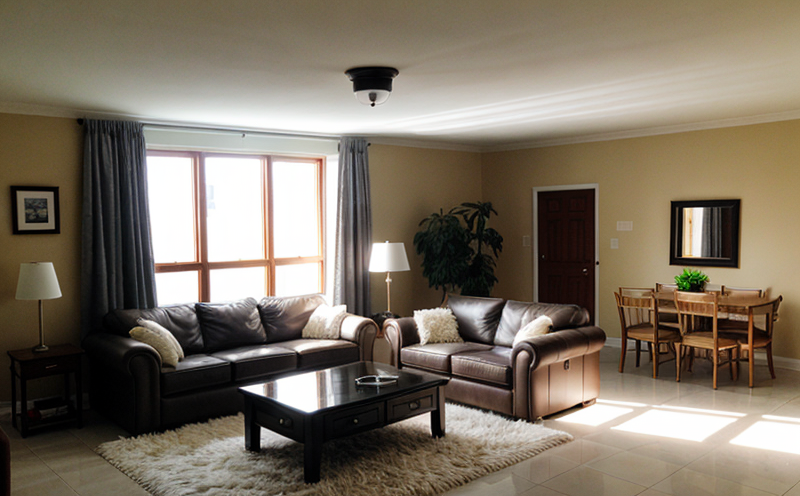EN 60529 IP Testing of Indoor Lighting Enclosures
The International Electrotechnical Commission (IEC) standard EN 60529 is designed to ensure that electrical and electronic equipment, including indoor lighting enclosures, are protected against ingress of foreign objects. This test evaluates the effectiveness of the enclosure's design in protecting its internal components from dust and water ingress. Compliance with this standard ensures reliability and safety for end-users.
The testing process involves subjecting the specimen to various environmental conditions that simulate real-world scenarios where contaminants such as dust or moisture might enter the device through openings, cracks, or gaps. The test is conducted in a controlled environment using specialized equipment that can replicate different levels of contamination and ingress pressure.
During the testing procedure, the enclosure is subjected to a series of tests that assess its ability to withstand specified levels of dust (e.g., IPX2 for up to 1 mm particles) or water (e.g., IPX4 for splashing water). The test setup typically includes a chamber where the specimen is placed and exposed to controlled conditions. The results are then compared against the standard's acceptance criteria, which vary depending on the specified protection class.
The importance of this testing cannot be overstated in industries such as commercial lighting, residential construction, and industrial facilities. Indoor lighting enclosures that fail to meet these standards can lead to premature failure due to water or dust ingress, resulting in reduced product lifespan and increased maintenance costs. Compliance with EN 60529 not only ensures the quality of the products but also enhances user safety by preventing potential hazards.
For R&D engineers, understanding the nuances of this test is crucial for designing robust enclosures that meet both functional performance requirements and regulatory standards. This includes selecting appropriate materials, optimizing design features, and ensuring proper sealing techniques to achieve the desired IP rating. Quality managers can leverage EN 60529 testing as a key metric in their quality assurance processes, helping them identify areas for improvement and maintain consistent product quality.
Compliance officers play a vital role in ensuring that all products meet relevant regulatory requirements. By incorporating EN 60529 IP testing into their compliance strategy, they can confidently market products that adhere to international standards, thereby enhancing brand reputation and customer trust. For procurement teams, selecting suppliers who have this capability demonstrates a commitment to product quality and reliability.
The testing process itself involves several key steps: specimen preparation, chamber setup, application of environmental conditions, observation, and final evaluation against the standard's acceptance criteria. Specimens are typically cleaned and prepared according to the specified requirements before being placed in the test chamber. The chamber is then subjected to various combinations of dust and water ingress pressures.
Once testing is complete, detailed reports are generated, outlining the results for each IP rating. These reports serve as valuable documentation that can be used during audits or regulatory inspections. They also provide actionable insights for continuous improvement in design and manufacturing processes.
Why Choose This Test
- Ensures Safety: By confirming the enclosure’s ability to prevent dust and water ingress, this test enhances user safety by reducing potential hazards associated with electrical malfunctions due to environmental factors.
- Increases Product Lifespan: Compliance ensures that products are built to withstand real-world conditions, leading to extended product lifespans and reduced maintenance costs over time.
- Meets Regulatory Requirements: Many regions require compliance with EN 60529 standards as part of their regulatory framework. Meeting these requirements avoids penalties and ensures smooth market access.
- Promotes Brand Reputation: Demonstrating adherence to international standards can significantly enhance brand reputation, attracting more customers and building long-term relationships.
Environmental and Sustainability Contributions
- Energy Efficiency: Enclosures that pass EN 60529 IP testing often incorporate features that contribute to energy efficiency. For example, well-sealed enclosures can prevent heat loss or gain, which in turn improves the overall performance of lighting fixtures.
- Material Usage Optimization: The rigorous design and testing process encourages manufacturers to optimize material usage, leading to more sustainable product development practices.
The use of EN 60529 IP testing aligns with broader sustainability goals by promoting the creation of durable products that require less frequent replacement. This reduces waste generation and supports a circular economy model where resources are used efficiently and responsibly.
Use Cases and Application Examples
| Industry Sector | Product Type | Description |
|---|---|---|
| Commercial Lighting | LED Downlights | Ensuring that LED downlight enclosures can withstand outdoor environments, including dust and water. |
| Residential Construction | Bathroom Fixtures | Verifying that bathroom fixtures are protected against moisture ingress to prevent electrical hazards in humid areas. |
| Industrial Facilities | Workplace Lighting | Evaluating the robustness of workplace lighting enclosures used in harsh industrial environments, such as factories or warehouses. |
In each case, compliance with EN 60529 IP testing ensures that products are fit for purpose, meeting both functional and safety requirements. This is particularly critical in sectors where the environment can significantly impact product performance and user safety.





